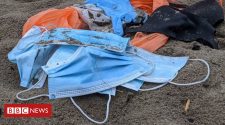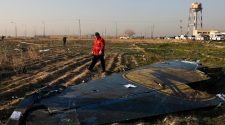South Louisiana has barely had time to catch its breath. But here we go again.
Warnings are mounting that the state could be in for another rough ride this hurricane season. Weather experts are pointing to factors such as particularly warm waters that could lead, once again, to an above-average storm year — perhaps even similar to the conditions in 2005 that led to hurricanes Katrina and Rita, one says.
Though forecasters don’t want to incite panic, preparation and awareness will be paramount, as in any season.
“This year’s weather pattern is very similar to last year and 2020,” said Dan Kottlowski, lead hurricane forecaster at AccuWeather, a commercial weather forecasting service.
“It’s safe to say that the threat for a direct hit this year, somewhere along the southeast Louisiana coast, again, is higher than normal,” he said.
South Louisiana residents need no reminders of what could be in store. Beyond the biblical-like destruction wrought by Katrina, the last couple years have ushered in two of the strongest hurricanes ever to make landfall in Louisiana.
Hurricane Laura ripped through southwest Louisiana in 2020, causing an estimated $17.5 billion in damage in the state. Hurricane Ida followed last year in the state’s southeast, pummeling bayou communities and beyond with $55 billion in estimated statewide damage.
Both were Category 4 storms with 150-mph winds. And in some ways, both could’ve easily been far worse with a slight shift of their paths.
Another hurricane in either region would take a further hit on communities still recovering. More than 9,000 households are currently living in post-storm trailers and mobile homes provided by FEMA and the state.
Casey Tingle, head of the Governor’s Office of Homeland Security and Emergency Preparedness, said the various forecasts do not necessarily change how the state prepares, since it must be ready for any outcome. But the destruction of the past couple years complicates those efforts, as the state must remind residents living in fragile temporary housing to take special precautions to weather the storm.
“The thing that probably gives us some concern that we wouldn’t normally have to address is just the vulnerability of so many of our communities because they are still in the recovery process from the storms of 2020 and Hurricane Ida in 2021,” said Tingle.
“So that vulnerability when combined with what we’re seeing in terms of these strong storms in the recent years — those factors together do create some challenges that require us to do a little bit of extra work in terms of what preparedness looks like.”
Tingle’s office advises residents to have a plan prepared as well as at least three days’ worth of supplies. Advice can be found at the state’s getagameplan.org website.
Supercharged storms?
A major indicator will be unveiled on Tuesday, when the National Oceanic and Atmospheric Administration issues its closely watched outlook for the Atlantic hurricane season, which begins June 1 and ends Nov. 30.
Meanwhile, several independent outlooks have already indicated the possibility of higher-than-normal storm activity.
AccuWeather’s model predicts 16 to 20 named storms. That includes three to five major hurricanes, or Category 3 and above. That’s above a 30-year average of 14 named storms per year and three major hurricanes.
Colorado State University’s predictions, released in April, are similar. Researchers there predicted 19 named storms and four major hurricanes this season; another forecast is expected in early June.
Named storms become hurricanes at 74 mph; Category 3 start at 111 mph. (Image by The Conversation/CC-BY-ND. Source: National Hurricane Center)
University of Arizona forecasters also predict an above-average year, but less so than recent seasons. They predict 14 named storms and three major hurricanes.
In labeling that above average, they compare the numbers to the median since 1980, which amounts to 13 named storms and two major hurricanes. They will also issue an updated prediction in early June.
While Arizona professor Xubin Zeng said he was not expecting a “super active year,” he said he is worried that conditions in the Gulf could create a situation similar to 2021.
On top of those, one weather expert has caused waves with a particularly frightening comparison for south Louisiana. Nick Shay, of the University of Miami, said one factor looks similar to 2005, the year of Katrina and Rita.
Shay wrote in The Conversation, a nonprofit that publishes articles by experts, that the “Loop Current,” the current of warm water that moves in from the Caribbean, is “unusually far into the Gulf for this time of year.”
Storms can draw strength from the Loop Current and its warm waters. Shay says it can “supercharge” hurricanes.
“I have been monitoring ocean heat content for more than 30 years as a marine scientist,” he wrote. “The conditions I’m seeing in the Gulf in May 2022 are cause for concern.”
Kottlowski noted, however, that the Loop Current shifts, and that it may look differently as the season develops.
Early preparation is key, officials warn
Either way, recent trends are undeniable. The head of the National Hurricane Center, Ken Graham, says the country has seen more Category 4 and 5 storms make landfall in the United States from 2017 to 2021 than it did from 1963 to 2016.
Last year was the third most-active season with 21 named storms, behind the 2020 and 2005 seasons, according to the Hurricane Center.
Climate change is believed to be increasing the likelihood of extreme weather and contributing to the intensification of storms, and it is expected to become an even greater factor in future years.
Louisiana is not generally at higher risk to being hit than other states across the roughly 1,700-mile U.S. Gulf Coast, said AccuWeather’s Kottlowski. One factor that may be at play, however, is that the increased number of storms in recent years has boosted the likelihood of their paths matching up with a positioning of what is known as the Bermuda-Azores high pressure center that could guide them in the state’s direction, he said.
For this year’s predictions, forecasters are looking at above-normal water temperatures in key areas and weather patterns in the Pacific, among other indicators. The Pacific this year includes what is known as a La Nina pattern, which essentially means less wind to shear through tropical formations in the Atlantic and weaken their development, said Kottlowski.
Regardless, Louisiana unfortunately has long experience in hurricane preparation and response, and hopes to build upon past experience.
Tingle said preparing early and moving supplies into place with sufficient time to spare will be key. Those who remain in trailers supplied by the state should not try to take the structures with them when they evacuate, he said.
Residents should also have an idea of where they want to go and communicate that plan with their relatives.
“We really want the public to know and have a way to stay in contact with their local officials, because that’s where the best information is going to be coming from,” Tingle said.















